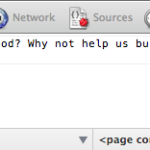How Search Works
Really impressive.
Apple Versus Wall Street: Don’t Pity the Hedgies
Apple Versus Wall Street: Don’t Pity the Hedgies
John Cassidy has an interesting perspective on what’s motivating David Einhorn’s battle with Apple’s management:
According to a piece on Forbes.com, Einhorn and Tepper paid an average of about five hundred and seventy-seven dollars for their shares, which suggests that they are each sitting on a paper loss of close to a hundred and thirty million dollars. Naturally, they aren’t pleased, but their predicament isn’t Cook’s responsibility.
In buying Apple shares last year, when the stock was heading for seven hundred dollars, investors were willfully ignoring the law of large numbers and the laws of supply and demand. With Apple’s annual revenues reaching a hundred and fifty billion dollars and rivals, like Samsung, launching top-notch products at lower prices, its rapid growth rate and expansive profit margins were virtually certain to come down. Now that’s happened, a bit sooner than expected, and the stock has cratered even as Apple has continued to post record-breaking numbers: in its most recent quarter, which ended on December 29th, Apple reported $13.1 billion in profits on revenues of $54.5 billion, an all-time record for the company. (By comparison, Exxon Mobil, the oil juggernaut, generated $9.95 billion in profits during its most recent quarter.)
If Einhorn and Tepper were really as smart as their media cuttings suggest they are, they would have been shorting Apple’s stock, not piling in with everybody else. But they decided to play the momentum game, which backfired on them. Now Einhorn is trying to bully Cook into distributing some of the hundred and forty billion dollars in cash that is sitting on Apple’s balance sheet, which translates to about sixty-five dollars per share. As a stockholder, that is his right: Apple is a public company, after all.
M.I.T. Computer Program Reveals Invisible Motion in Video
Ang Lee and the uncertainty of success
Ang Lee and the uncertainty of success
From age 30 to 36, [Ang Lee is] living in an apartment in White Plains, NY trying to get something — anything — going, while his wife Jane supports the family of four (they also had two young children) on her modest salary as a microbiologist. He spends every day at home, working on scripts, raising the kids, doing the cooking. That’s a six-year span — six years! — filled with dashed hopes and disappointments. “There was nothing,” he told The New York Times. “I sent in script after script. Most were turned down. Then there would be interest, I’d rewrite, hurry up, turn it in and wait weeks and weeks, just waiting. That was the toughest time for Jane and me. She didn’t know what a film career was like and neither did I.” It got so discouraging that Lee reportedly contemplated learning computer science so he could find a job during this time, but was scolded by his wife when she found out, telling him to keep his focus.
Put yourself in his shoes. Imagine starting something now, this year, that you felt you were pretty good at, having won some student awards, devoting yourself to it full time…and then getting rejected over and over until 2019. That’s the middle of the term of the next President of the United States. Can you imagine working that long, not knowing if anything would come of it? Facing the inevitable “So how’s that film thing going?” question for the fifth consecutive Thanksgiving dinner; explaining for the umpteeth time this time it’s different to parents that had hoped that film study meant you wanted to be a professor of film at a university.
On disclosures, Instagram photos of your kids, and the “artist as genius” myth
This March marks ten years since the United States led an invasion of Iraq based on bad intelligence about Saddam Hussein’s weapons-of-mass-destruction programs. That dark anniversary offers a reminder, if one is required, that in any conflict where a President claims war powers the Chief Executive’s analytical precision in describing the enemy is a grave responsibility. A franchise is a business that typically operates under strict rules laid down by a parent corporation; to apply that label to Al Qaeda’s derivative groups today is false. If Al Qaeda is not coherent enough to justify a formal state of war, the war should end; if the Administration wishes to argue that some derivative groups justify emergency measures, it should identify that enemy accurately.
Jihadist violence presents an enduring danger. Its proponents will rise and ebb; the amorphous threats that they pose will require adaptive security policies and, occasionally, military action. Yet the empirical case for a worldwide state of war against a corporeal thing called Al Qaeda looks increasingly threadbare. A war against a name is a war in name only.
We Saw Your Boobs” was as a song-and-dance routine in which MacFarlane and some grinning guys named actresses in the audience and the movies in which their breasts were visible. That’s about it. What made it worse was that most of the movies mentioned, if not all (“Gia”), were pretty great—“Silkwood,” “Brokeback Mountain,” “Monster’s Ball,” “Monster,” “The Accused,” “Iris”—and not exactly teen-exploitation pictures. The women were not showing their bodies to amuse Seth MacFarlane but, rather, to do their job. Or did they just think they were doing serious work? You girls think you’re making art, the Academy, through MacFarlane, seemed to say, but all we—and the “we” was resolutely male—really see is that we got you to undress. The joke’s on you. At a moment when Sheryl Sandberg, the Facebook chief operating officer, talks about how women have to “lean in” in the workplace, Seth MacFarlane pops up from behind to say, “So we can see your boobs.
This is exactly what I thought when watching this song. And as Davidson points out, this attitude persisted through the entire broadcast, including particularly classless fat jokes about Adele and Melissa McCarthy. As the father of a 2 year old daughter, I found the whole thing repugnant.
Every Steve Jobs Video
Exactly what it says on the tin.

